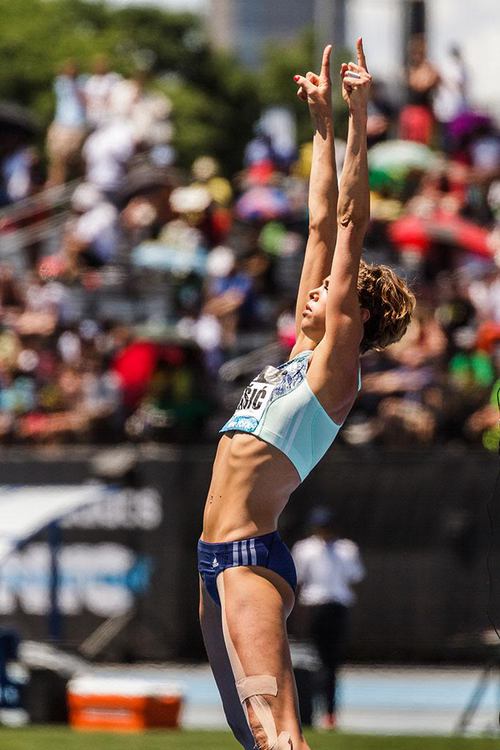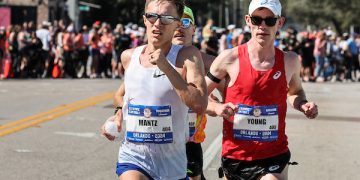 Blanka Vlasic, photo by Kevin Morris
Blanka Vlasic, photo by Kevin Morris
As a freshman at DeSmet Jesuit High School, in October of 1972, Mr. Rich Grawer, my history teacher, wanted to familiarize us with proper research techniques. Over a series of weeks, I had to research, after decoding clues, the winners of the 1968 and 1972 Royal Dutchman sailing class in the Olympics. Learning how to use research available in a library was a good skill for 1972.
RelatedPosts
Now, many just go to google or wikipedia.
My university degrees are in history and painting. It was the seventies, but, the truth was, those were my two passions, well, besides athletics.
I was fortunate enough to have professors who helped us appreciate the complexities of dealing with contemporary sources. In this day and age, it can be virtually impossible to tell what is absolute crap and what is merely, well intentioned, but poorly attributed information.
Getting the rough picture of complicated situation does not mean one understands said situation. To quote a fairly modern troubadour, ” One should not describe a KISS concert if you have not been there.”
In our modern world of social media, much of the real stories are left out of the tweets, Facebook rants, and Instagram pictoids.
We live in a complex world.
In light of the pieces in BBC, Independent and Guardian on the supposed adidas departure, and the reactions I have recieved from many in the industry, I thought I would try to take away some of the confusion.
But then, maybe I will just add to it….
In track and field, no one makes money from sponsorship a championship.
The sponsorship of a World or regional championship cost significant money. A sponsor like adidas provides footwear, apparel for officials and volunteers, communications in local and global arenas, product tie ins for local retailers and access for media to key athletes and spokespeople to tell the brand story around the events. Access to athletes and spokespeople is carefully managed. That does not count the people hours that go into an event from the sponsor side.
Why do brands even do it?
Because it supports the sport, it provides the brand access to more consumers, it positions the brand as a key player in the global sports world. In most cases, brands do not make money from Global, regional or national sponsorships. They get the value in brand recognition, and the authenticity it generates.
How long does it take to plan such a sponsorship?
Years and years of work. Orders for uniforms and footwear must be done six months to a year out. Miss forcasts and one looks stupid. The good publicity a brand can get from sponsorships such as these can also turn sour when wrong shoe sizes, or worse, media back packs run out. It is silly what thousands of media peeps treasure from various champs. I have my 1999 Sevilla backpack and 1995 Goteborg t-shirts, among other paraphanalia.
Why have the value of Championships lessened in the eyes of some brands?
Look at what the big guys (and little guys) do: they sponsor national federations, they sponsor clubs, they sponsor athletes. First, start with the local heroes, then, the local clubs, then, the national clubs, then, the national federations.
But, if you have several dozen national federations, why do you need to be the global sponsor of the sport? That is what some brands might be thinking about now.
What possibly could sponsors be upset about?
Footwear brands sponsor running events, cross country running events, track and field events, ultra events, you name it, a brand will find a way to get involved, if it makes sense for their brand strategy.
What is different in branding for publicly traded companies?
In a finely written piece by David Owens, In defense of adidas, Mr. Owens explains that publicly traded companies have to protect their interest and their value. A sponsorship that is besmirched by doping and extortion allegations could, and I note, could, lower the value of a sponsorship.
Also, a poorly managed sponsorship, from agency to federation to events can also cause a sponsor consternation and frustration.
What is really going on with the adidas sponsorship?
What is really going is between the IAAF, Dentsu and adidas. My guess is that the frustration has been going on for some time on adidas’ part. Past footwear and apparel sponsors of the IAAF have been Reebok and Mizuno.
Differences in approaches between the three groups are obvious, but, no one knows the truth besides the players. Face it, if adidas was not concerned and following the WADA reports closely, they would not be doing their duty to protect their brand. Stockholders can and do sue over losses in values of various companies.
Dentsu’s job is to put a happy face on everything.
But, if one gives this writer some liberties, for just a few minutes, perhaps we can come to some interesting conclusions:
What if adidas was using the current media brouhaha to negotiate a better deal for an extension? (Doubtful, but give me this moment, please).This is quite common in sponsorship negotiations. A leak or misinterpretation of information and one story gets out that adidas is leaving, then, a second, and then, before you know it, Nike has already done a deal, because Seb Coe is the IAAF leader.
Has Mr. Coe visited the sponsor headquarters? Those types of visits and personal reaching out continue to mean alot in this world of rapidly moving media messaging.
A bit on Seb Coe and his relationship with Nike.
Those of us with some memory will remember that Nike cut Seb Coe after 1984 in favor of Steve Cram, the next British super star. Mr. Coe was less than happy about that. In fact, Seb became a distributor for Diadora. This writer actually did some work for Mr. Coe and that brand in the early 1990s in our magazine, American Athletics.
Seb Coe is a businessman and politician. Around the year, 2000, Nike hired Seb Coe to be an ambassador. This allowed Nike to work with Mr. Coe to showcase the brand at various events. The $100k consulting contract was pretty meager by Nike standards.
That he dropped the Nike consulting contract seems to be used in every attack on him from one of his countries’ media members. The relationship with Nike, means that, if and when Mr. Coe needs another footwear sponsor, he can, indeed speak to Nike.
That does not mean that Nike will take the bait. Why does everyone think that Nike will sponsor the IAAF?
Remember Mr. Owens’ eloquent arguement on adidas? Well, Nike is a publicly held business. Their long term sponsorship of USA Track & Field protects their business interest. Nike also sponsors another several dozen athletic federations, and several hundred athletes in our sport. If and only if the IAAF fits into Nike’s global marketing plans will they spend the money.
What do they gain from sponsoring the IAAF? Just because a writer from the a major media organization notes that Nike is in talks with the IAAF does not mean it is actually happening, or those talks will be completed. To find sponsors, one speaks to many possibilities. One must always check ones sources was an early lesson in secondary school, I believe.
Right now, the sport is reacting to all news stories. Seb Coe will be criticized if he belches in public (a You Tube exclusive). Pictures of a tired, unshaven Seb Coe are featured in stories, with absolutely fascinating headlines.
There is lot to be upset with the IAAF about, without making things up. But, as the demands from social media get more ridiculous, we need to remember what we are doing.
What about all of this Ed Warner comments, does he get along with Seb Coe?
Well, it sure seems like Mr. Warner could care less if Mr. Coe likes him or not. From the Manifesto, to the newest revelation that someone from IAAF noted that brown envelopes, chock full of money were being given out during the Doha/London 2017 vote, Mr. Warner has been quite popular on British media circuits.
It does take away from the poor management that UK Athletics has endured under his leadership. BBC cutting event coverage in UK to three events? At one time, there wer nine. Going from the best funded athletic federation in the world, to having most sponsorships go up in smoke. Perhaps that little idea about dumping Fasttrack, and keeping the sponsors and saving the commissions was not not as well thought out as possible. Mr. Warner needs to focus on his immediate issues, like funding his athletes and federation.
The IAAF Ethics committee should look at the World Championship bidding processes. It looks like London won despite the alleged efforts of their competitor and the brown envelopes.
Where is the sport now?
Several years ago, I was offered a package of fishing magazines. I turned them down.
There are days, well, hours, when I think that having several magazines on musky and walleye fishing and their very profitable expositions would be a much better day that struggling with athletics media, but I love the sport and business we have created over nearly three decades. Truth is, media in any form is a challenge today, as the consumer decides what they really want to see, listen to, read and watch.
I see as many opportunities each and every day with our sport. At the road running level and scholastic level, the sport is very healthy in North America, and around the world.
The sport has had great moments and some really bad moments. We are going through the worst time that I remember. For the sport to regain the stature it deserves, we must clean up the sport, and we must transform how everything is done, from promoting events and athletes, to showcasing our major events.
The IAAF has to show current and future sponsors that there is a clean, relatively honest global sport which has learnt from the past corruption and extortion.
Doping was one thing, and that was tawdry enough. The extortion, and the level of extortion is quite another. The level of corruption, while rumored, was another thing to see in almost five hundred pages of WADA reports.
The feeding frenzy continues, and I am not sure when it will stop.
I am looking forward to some good indoor track meetings and the upcoming Olympic Marathon Trials.
Because, even with all of the revelations, there is something still about the sport that attracts many of us.
Don’t kill the sport, clean it up.
That is what the athletes, coaches, fans want to see, more than anything else.





















